We've been busy covering election issues and other pressing matters, but the fully weaponized police military state that the U.S. has become post-9/11 --- as we reported in great detail late last year --- continues apace.
Last night, another horrifying example occurred out here near Los Angeles at Santa Monica College were campus security guards reportedly pepper sprayed some 30 students, without warning, in the hallway just outside of an open Board of Trustees meeting. Several hundred had shown up to try and voice their opinions during (ironically enough) the Public Comment period about the cost of some classes being raised by as much as 400% percent.
We've yet to see video of the actual use of the chemicals said to have been used, but this was the scene just after it...
While I don't believe it's yet been confirmed, there were several reports of either a 4 or 5-year old being among those doused with pepper spray, even while there were no arrests made.
In other words, the use of chemical weapons on peaceful demonstrators (and, perhaps, infants) now appears to be among the first, rather than a last resorts used in the disturbing rise of "police" violence against peaceful citizens expressing their First Amendment rights.
Via Xeni Jardin's report at BoingBoing, we're pointed to the following disturbing observation from blogger zunguzungu --- a student at UC Berkley, where cops resorted to the violent use of batons to break up peaceful student demonstrators last November (video here) --- on the troubling implications of what happened last night in Santa Monica and at several other recent attempts at peaceful demonstration...
Or, rather, it was. A crowd must be dispersed before it does something, goes the logic of the new preemptive policing; a crowd is, itself, a clear and present danger. If you wait until the crowd actually does something, you’ve waited too long. And so you preempt it by striking first.
If you doubt that this is the way these people think, I’d invite you to read Jeff Young — the current assistant police chief at UCLA — writing his “operational review” of UC Berkeley’s police actions against protesters from last November 9th, and note that his main takeaway was that campus police should have probably been allowed to use pepper spray. For more successful protest management, he decides, what the police need is more force options. Perhaps Tasers?
That’s not a joke. He actually observes that while Tasers are “a fairly new crowd management tactic for police,” they “have proven to be very effective,” and notes that a “special panel of the Chancellor of UCLA rigorously reviewed the use of these devices [and] found the use of this level of force within applicable law and police policy.”
Again, this wasn't even an official metropolitan police force using pepper spray in Santa Monica. It was the campus security guards. Nonetheless, the Santa Monica Police were called out, in force, shortly thereafter.
Santa Monica College is not the only one facing extraordinary increases in student tuition. A report last month detailed that it may now cost more to attend the University of California and California State University systems than it costs to go to Harvard, Princeton or Yale.
A report published yesterday by Demos details how, from 1990 to 2010, state funding for higher education, per full-time student, has plunged 26%.
"As state support has declined," the report explains, "institutions have balanced the funding equation by charging students more. Between 1990-1991 and 2009-2010, published prices for tuition and fees at public four-year universities more than doubled, rising by 116 percent, after adjusting for inflation, while the real price of two-year colleges climbed by 71 percent."
All the while, as tuition costs for educating our citizens have increased across the nation, we've fought two incredibly long and unnecessary wars, have been forced to lay off nurses, police and firefighters, cut public services to the most needy and, at the same time, give huge tax cuts to the rich who don't need it, billions in free money to the Wall Street firms who tanked the world economy, all the while as U.S. corporations continue to turn all-time record profits.
Jardin's BoingBoing report included a tweet from @mary_menville on the incident last night which seems to have captured the American disease well...



 Trump Losing Streak Continues into SECOND Hundred Days: 'BradCast' 5/1/25
Trump Losing Streak Continues into SECOND Hundred Days: 'BradCast' 5/1/25 'Green News Report' 5/1/25
'Green News Report' 5/1/25
 100 Daze:
100 Daze: Campaign to 'Impeach Trump Again' Gains Fresh Momentum: 'BradCast' 4/29/25
Campaign to 'Impeach Trump Again' Gains Fresh Momentum: 'BradCast' 4/29/25 'Green News Report' 4/29/25
'Green News Report' 4/29/25 And Then They Came for the Judges...: 'BradCast' 4/28/25
And Then They Came for the Judges...: 'BradCast' 4/28/25 Sunday 'Desperation' Toons
Sunday 'Desperation' Toons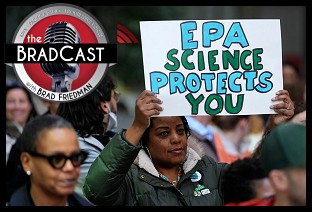 Trump EPA Guts Enviro Justice Office: 'BradCast' 4/24/25
Trump EPA Guts Enviro Justice Office: 'BradCast' 4/24/25 'Green News Report' 4/24/25
'Green News Report' 4/24/25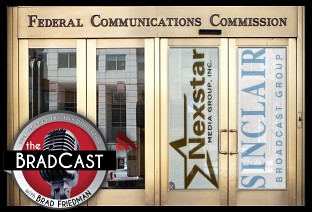 Nation's Largest Broadcaster Hoaxes Viewers to Help Gut FCC Rules: 'BradCast' 4/23/25
Nation's Largest Broadcaster Hoaxes Viewers to Help Gut FCC Rules: 'BradCast' 4/23/25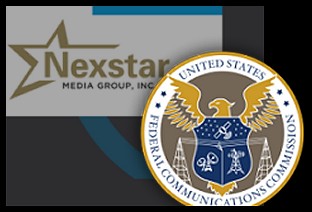 Trump's FCC on Precipice of Ending All Limits on Corporate Control of Local TV Stations
Trump's FCC on Precipice of Ending All Limits on Corporate Control of Local TV Stations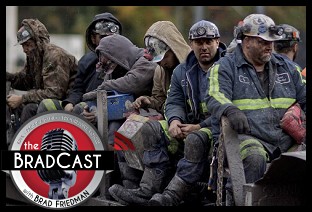 GOP Earth Day 2025 Hypocrisies and Dilemmas: 'BradCast' 4/22/25
GOP Earth Day 2025 Hypocrisies and Dilemmas: 'BradCast' 4/22/25 'Green News Report' 4/22/25
'Green News Report' 4/22/25 Pope Francis Dies, Trump Still Alive and Criming: 'BradCast' 4/21/25
Pope Francis Dies, Trump Still Alive and Criming: 'BradCast' 4/21/25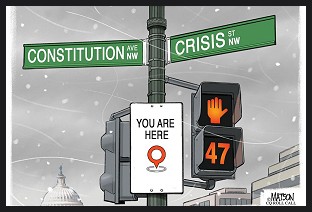 Sunday
Sunday  Sunday 'Zero Day' Toons
Sunday 'Zero Day' Toons 'Green News Report' 4/10/25
'Green News Report' 4/10/25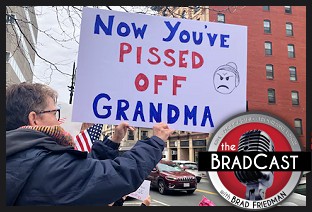 Soc. Sec. Expert Warns DOGE of Collapse, Privatization: 'BradCast' 4/10/2025
Soc. Sec. Expert Warns DOGE of Collapse, Privatization: 'BradCast' 4/10/2025 Trump Blinks, Chaos Reigns, Markets Spike Amid Tariff 'Pause': 'BradCast' 4/9/25
Trump Blinks, Chaos Reigns, Markets Spike Amid Tariff 'Pause': 'BradCast' 4/9/25 SCOTUS Deportation Ruling Grimmer Than First Appears: 'BradCast' 4/8/25
SCOTUS Deportation Ruling Grimmer Than First Appears: 'BradCast' 4/8/25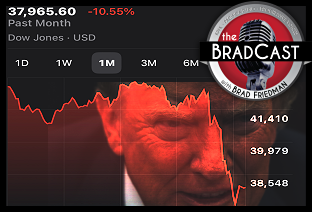 Cliff Diving with Donald: 'BradCast' 4/7/25
Cliff Diving with Donald: 'BradCast' 4/7/25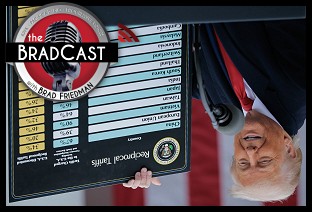 'Mob Boss' Trump's Trade Sanctions Tank U.S., World Markets: 'BradCast' 4/3/25
'Mob Boss' Trump's Trade Sanctions Tank U.S., World Markets: 'BradCast' 4/3/25 Crawford Landslide in WI; Booker Makes History in U.S. Senate: 'BradCast' 4/2/25
Crawford Landslide in WI; Booker Makes History in U.S. Senate: 'BradCast' 4/2/25 Judge Ends Challenge to GA's Unverifiable, Insecure Vote System: 'BradCast' 4/1/25
Judge Ends Challenge to GA's Unverifiable, Insecure Vote System: 'BradCast' 4/1/25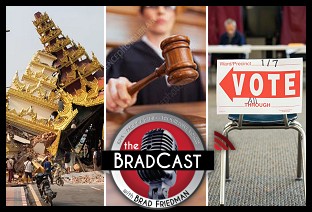 Bad Court, Election News for Trump is Good News for U.S.: 'BradCast' 3/31
Bad Court, Election News for Trump is Good News for U.S.: 'BradCast' 3/31
 VA GOP VOTER REG FRAUDSTER OFF HOOK
VA GOP VOTER REG FRAUDSTER OFF HOOK Criminal GOP Voter Registration Fraud Probe Expanding in VA
Criminal GOP Voter Registration Fraud Probe Expanding in VA DOJ PROBE SOUGHT AFTER VA ARREST
DOJ PROBE SOUGHT AFTER VA ARREST Arrest in VA: GOP Voter Reg Scandal Widens
Arrest in VA: GOP Voter Reg Scandal Widens ALL TOGETHER: ROVE, SPROUL, KOCHS, RNC
ALL TOGETHER: ROVE, SPROUL, KOCHS, RNC LATimes: RNC's 'Fired' Sproul Working for Repubs in 'as Many as 30 States'
LATimes: RNC's 'Fired' Sproul Working for Repubs in 'as Many as 30 States' 'Fired' Sproul Group 'Cloned', Still Working for Republicans in At Least 10 States
'Fired' Sproul Group 'Cloned', Still Working for Republicans in At Least 10 States FINALLY: FOX ON GOP REG FRAUD SCANDAL
FINALLY: FOX ON GOP REG FRAUD SCANDAL COLORADO FOLLOWS FLORIDA WITH GOP CRIMINAL INVESTIGATION
COLORADO FOLLOWS FLORIDA WITH GOP CRIMINAL INVESTIGATION CRIMINAL PROBE LAUNCHED INTO GOP VOTER REGISTRATION FRAUD SCANDAL IN FL
CRIMINAL PROBE LAUNCHED INTO GOP VOTER REGISTRATION FRAUD SCANDAL IN FL Brad Breaks PA Photo ID & GOP Registration Fraud Scandal News on Hartmann TV
Brad Breaks PA Photo ID & GOP Registration Fraud Scandal News on Hartmann TV  CAUGHT ON TAPE: COORDINATED NATIONWIDE GOP VOTER REG SCAM
CAUGHT ON TAPE: COORDINATED NATIONWIDE GOP VOTER REG SCAM CRIMINAL ELECTION FRAUD COMPLAINT FILED AGAINST GOP 'FRAUD' FIRM
CRIMINAL ELECTION FRAUD COMPLAINT FILED AGAINST GOP 'FRAUD' FIRM RICK SCOTT GETS ROLLED IN GOP REGISTRATION FRAUD SCANDAL
RICK SCOTT GETS ROLLED IN GOP REGISTRATION FRAUD SCANDAL VIDEO: Brad Breaks GOP Reg Fraud Scandal on Hartmann TV
VIDEO: Brad Breaks GOP Reg Fraud Scandal on Hartmann TV RNC FIRES NATIONAL VOTER REGISTRATION FIRM FOR FRAUD
RNC FIRES NATIONAL VOTER REGISTRATION FIRM FOR FRAUD EXCLUSIVE: Intvw w/ FL Official Who First Discovered GOP Reg Fraud
EXCLUSIVE: Intvw w/ FL Official Who First Discovered GOP Reg Fraud GOP REGISTRATION FRAUD FOUND IN FL
GOP REGISTRATION FRAUD FOUND IN FL

































